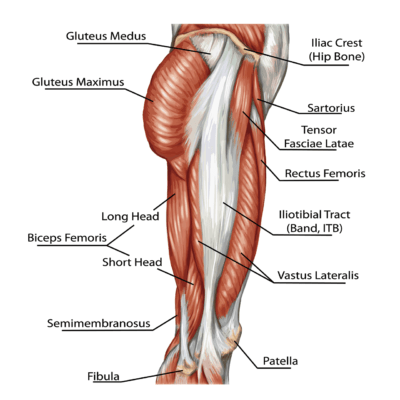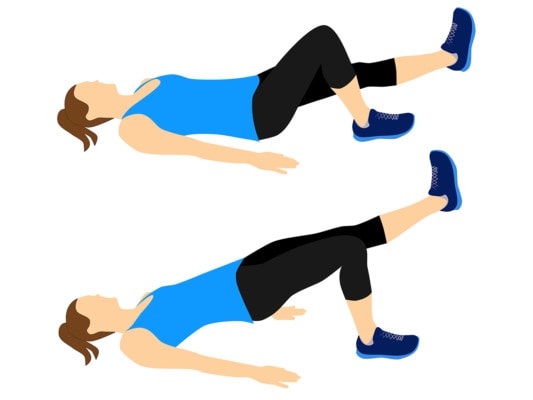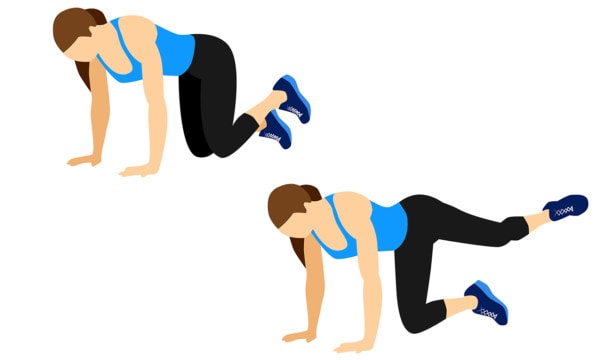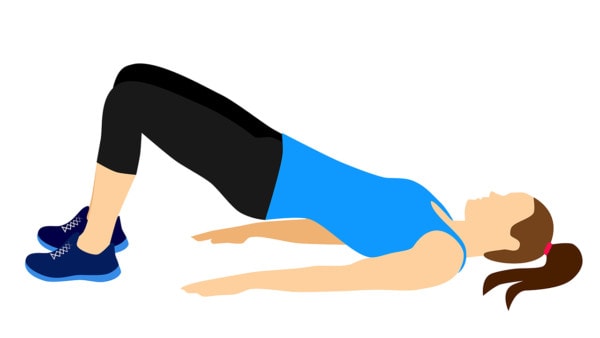The Glutes and the ITB
The ITB is one of those parts of the body that everyone loves to hate. When gyms were open, you would invariably see dozens of people a day rolling out their tight and tender ITBs. However, what most of these people don’t know is that the way to a painless ITB future is often getting your butt muscles back online. Let’s review.
The Anatomy
The ITB (iliotibial band) is like a piece of duct tape that runs from the side of the top of your hip (iliac crest) and down across the side of your hip bone (greater trochanter) and then down to your knee (Gerdy’s Tubercle). One of the reasons that people misunderstand this structure is that they have no idea that it’s actually linked into strong muscles and is nothing more than a way for those muscles to transfer force. Let’s dig in on that concept.

Stihii/Shutterstock
There are three muscles you need to know: the gluteus Maximus, tensor fascia latae, and vastus lateralis. The GMax (gluteus maximus) has the biggest single input into the ITB at the hip as it’s a massive muscle that makes up most of your buttocks. The tensor fascia lata comes in from the front of the hip as shown here. The ITB is actually the lateral wall of the vastus lateralis, so it’s also a critical input on the structure.
Of these three muscles, if you had to work on one to get rid of ITB tightness and pain, your GMax would be the one to consider. Why? It helps to control the tension in the duct tape and is also a muscle that goes south in most of us as we age.
To learn more about the ITB, see my video below:
GMax and Flatt Butts
As we get older, for many of us, our butts get flatter. Why? the nerves that supply the main butt muscle (GMax) come from the lowest part of the low back at L5-S1. Even in people without back pain, these nerves can get irritated because this is the most commonly degenerated spinal level due to wear and tear. Hence, the amount of nerve firing in the GMax declines with age. Anytime a nerve isn’t supplying a muscle well, that muscle atrophies.
This is all made much worse if you have chronic lower back pain. Why? These nerves are often involved, so that’s a double whammy in addition to aging.
Flatt Butts and the ITB
When the GMax atrophies, it’s ability to keep the duct tape of the ITB taught goes way down. This then causes the ITB to begin vibrating and jumping around ever so slightly when you walk or run. It’s this extra movement of the ITB that leads to inflammation in the structure. This then causes a tight and tender ITB.
Getting Rid of a Flat Butt Can Help Your ITB
When a patient comes into the office with ITB pain, I have a number of go-to exercises I use. These are all designed to increase the ability of the GMax and other gluteal muscles to contract:

Katule/Shutterstock

Katule/Shutterstock

Katule/Shutterstock
Do these exercises every day, starting with the one on the far right (easiest) and working toward the middle and then the far left as you advance.
My ITB Example
This weekend I was hiking in the Colorado mountains and my ITB began to hurt. That pain used to be my constant companion until I began the exercises you see above and then it slowly went away. It’s return caught me by surprise until I realized that I had not been doing these exercises due to a change in my workout routine. However, the next day, I did the above exercises above before going on a hike and the pain was gone again. Realize that this quick result was only possible because I had previously spent months working on these exercises to built up my GMax.
What if the ITB Pain Doesn’t Go Away?
There are circumstances where the ITB is just too beat up from years of abuse. In that case, you may not get relief from these exercises. In patients with that problem (tendinopathy of the ITB), we often use precise ultrasound-guided PRP injections into the ITB to promote healing.
The upshot? If like many people you have a tight and painful ITB, getting your butt muscles back online is key. Try the exercises above diligently for a few months and based on my experience, this will help that ITB. If it doesn’t we’ve also got you covered via regen med options.

NOTE: This blog post provides general information to help the reader better understand regenerative medicine, musculoskeletal health, and related subjects. All content provided in this blog, website, or any linked materials, including text, graphics, images, patient profiles, outcomes, and information, are not intended and should not be considered or used as a substitute for medical advice, diagnosis, or treatment. Please always consult with a professional and certified healthcare provider to discuss if a treatment is right for you.
